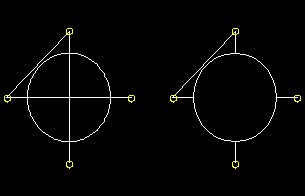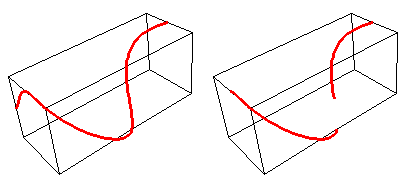Context:
Assembly-level wire features are nonmeshable. The wire feature contains wires connecting points from the part or assembly in the current viewport or connecting points from the part or assembly to ground. To model connectors you must define one or more wire features on your assembly. When you create a wire feature on a part or an assembly, you can create a geometry set that includes the wires defined in the wire feature. In addition, when you create a wire feature on a part, you can create geometry sets that include the vertices defined in the wire feature.
To add a wire feature on a part, select from the main menu bar in the Part module. The point-to-point wire tool is always available in the Part module, regardless of the modeling space of the part in the current viewport. To add a wire feature on an assembly, select from the main menu bar in the Interaction module.
You add a point-to-point wire feature to a part by choosing a geometry type, polyline or spline; for assemblies you can add only a polyline wire feature. You can choose to imprint the wire on the existing part by creating edges, merge the wire with the existing part, or create the wire separate from the existing part. The wire merge options are available only in the Part module.
If you are creating polyline wires, you must next choose a point selection method and pick points to connect from the current part or assembly. You can choose to select disjointed points (i.e., not automatically connected end-to-end), chained points (i.e., automatically connected end-to-end), or points that are connected to ground. Abaqus/CAE connects the point pairs with a straight line or connects the points to ground depending on the method that you select. A polyline wire feature connecting four points in a part is illustrated in the following figure:

The planar shell feature is shown for reference. The image on the left shows the full length of the point-to-point wire using the Imprint wire or Separate wire options, while the image on the right shows a point-to-point wire connecting the same set of points using the Merge wire option.
If you are creating spline wires on a part, the chained point selection method is the only one available. Abaqus/CAE calculates the shape of the curve by using a cubic spline fit between all points along the spline; in addition, the first and second derivatives of the spline are continuous. A spline wire feature is illustrated in the following figure:

The rectangular solid feature is shown for reference. The image on the left shows the full length of the spline wire using the Imprint wire or Separate wire options, while the image on the right shows a spline wire connecting the same set of points using the Merge wire option.
During creation of the wire feature on a part or assembly, you can modify the point selections. For part-level wire features, in most cases, once you have created the wire feature, you cannot modify it directly. You may be able to remove a wire edge from the feature using the Geometry Edit toolset. (For more information, see Removing wire edges). If you want to change the points that are connected or the connection order, you must delete the wire and create a new wire connecting the desired points. Since the point-to-point wire is dependent on points created by other features, you can modify the wire by using the Feature Manipulation toolset to modify the features that created the points.
Although you cannot create a part with a nonplanar wire base feature, you can create a nonplanar point-to-point wire feature by using a single point in space as the base feature and entering coordinates for the remaining points. In this case the starting point is the only point that you can edit to modify the wire. You can also use datum points, in which case you can edit all points.
Display the Create Wire Feature dialog box using one of the following methods:
-
From the main menu bar in the Part module, select .
-
From the main menu bar in the Interaction module, select .
If you are creating a wire in the Part module, choose Polyline to create one or more straight lines or choose Spline to create a continuous spline curve.
If you are adding a wire feature to a part, specify a merge option in the Wire Merge Scheme portion of the dialog box. The wire merge options are available only in the Part module.
-
Choose Imprint wire to imprint the newly created wire on the existing part by creating edges.
-
Choose Merge wire to merge the newly created wire with the existing part.
-
Choose Separate wire to create the wire separate from the existing part; no edges are created and the wire is not merged with the existing part.
In the Point Pairs portion of the dialog box, specify the point selection method.
-
Choose Disjoint wires to select points that are not automatically connected end-to-end. Use this method to specify wires to use for modeling connectors (see Modeling connectors).
The first two points that you select become Point 1 and Point 2, respectively, of a point pair; the next two points that you select become Point 1 and Point 2, respectively, of the next point pair; and so on. When you use connectors to model multi-point constraints between two points, the motion of Point 2 is constrained to the motion of Point 1.
-
Choose Chained wires to select points that are automatically connected end-to-end. The first point that you select becomes Point 1 of a point pair, the second point that you select becomes Point 2 of that point pair and Point 1 of the next point pair, and so on.
For spline wires, Chained wires is the only selection method available, and points are displayed separately instead of in pairs.
-
Choose Wires to ground to select points that are connected to ground. Use this method to specify point-to-ground wires to use for modeling connectors (see Modeling connectors). Abaqus/CAE automatically makes each point that you select Point 2 of a point pair (i.e., Point 2 is connected to ground). However, you may want to connect Point 1 to ground. If so, you can modify the wire definition after you complete the point selection. Select the row of the point pair that you want to modify, and click Swap to exchange the entries for Point 1 and Point 2 (as described in Step 5).
In the Point Pairs portion of the dialog box, click  to select the points that the wire will connect.
to select the points that the wire will connect.
-
If you are adding a wire feature to a part, you can select points from the viewport or you can enter the coordinates in the text box in the prompt area. Abaqus/CAE highlights all the points that you can pick. The possible choices are:
-
If you are adding a wire feature to an assembly, you can select points from the viewport. Abaqus/CAE highlights all the points that you can pick. The possible choices are:
-
Vertices
-
Orphan nodes
-
Reference points
Abaqus/CAE displays prompts in the prompt area to guide you through the procedure.
As you select points, Abaqus/CAE displays a representation of the completed point-to-point wire based on your current selections highlighted in red.
When you have finished selecting points, click Done in the prompt area.
The Create Wire Feature dialog box reappears. The points that you selected to define the wire are listed in the Point Pairs table.
From the Point Pairs table, you can do the following:
-
To add more point pairs to a polyline or to add more points to a spline, repeat Steps 3 through 5.
Note:
When you add points to a spline, the new points will always extend the existing spline from the last existing point. When you add point pairs to a polyline, they will be connected to the existing polyline only if you reselect one of the existing points.
For polylines, the added point-to-point wire segments are highlighted in magenta. For splines, the entire spline wire is highlighted in red because its shape depends on the entire set of points, both new and existing.
-
To edit a point, select the point in the table, click  , and reselect a point. The selection in the viewport is updated to show the newly edited point.
, and reselect a point. The selection in the viewport is updated to show the newly edited point.
-
To identify a specific point pair in the viewport, select the desired row. For polylines, the line connecting the selected point pair is highlighted in red. For splines, the symbol for the point on the selected row is highlighted.
-
To remove a point pair from a polyline or a point from a spline, select the desired row and click  .
.
-
To exchange the entries for Point 1 and Point 2 in a point pair for polylines, select the desired row and click  .
.
You can also enter table data from an ASCII file. To enter data from a file, click mouse button 3 while holding the cursor over a cell in the table; then select Read From File from the menu that appears. For more information, see Entering tabular data.
In the Set Creation portion of the dialog box, do the following:
-
Toggle on Create set of wires if you want Abaqus/CAE to create a geometry set of wires.
-
Toggle on Create set of vertices if you want Abaqus/CAE to create a geometry set of the Point 1 entries and a geometry set of the Point 2 entries in the wire definition. The Create set of vertices option is available only in the Part module.
Click OK to create the point-to-point wire feature.
Part-level wire features appear as solid lines in the viewport and appear in the Model Tree in the Features container under the part.
Assembly-level wires features are nonmeshable, appear as dashed lines in the viewport, and appear in the Model Tree in the Features container under the assembly.


 tool, located with the wire tools in the
tool, located with the wire tools in the  tool, located in the
tool, located in the  to select the points that the wire will connect.
to select the points that the wire will connect.  , and reselect a point. The selection in the viewport is updated to show the newly edited point.
, and reselect a point. The selection in the viewport is updated to show the newly edited point. .
. .
.